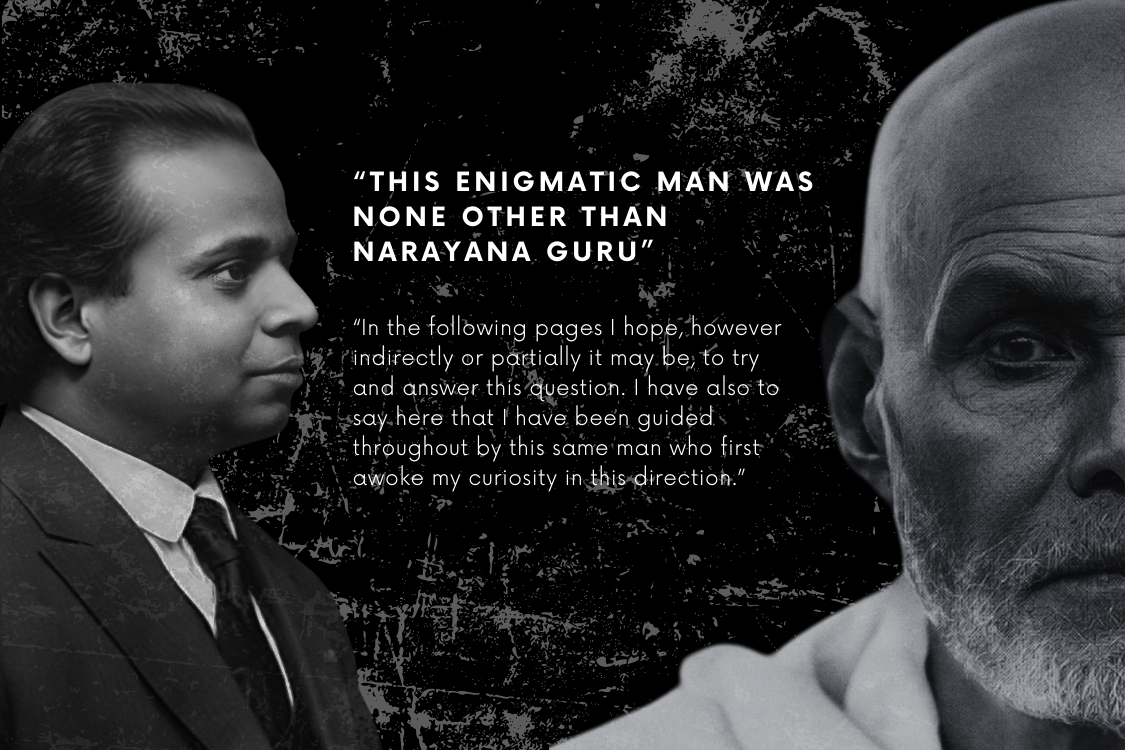NG through Nataraja Guru
Narayana Guru: Through the Scientific Pen of Nataraja Guru
Narayana Guru lived during a time of deep social divisions and caste-based injustices. His efforts towards social reform were groundbreaking, advocating for equality, dismantling caste barriers, and promoting education. However, reducing his impact solely to these reforms would be to overlook the philosophical depth of his teachings. His vision extended beyond the immediate social conditions of his time, addressing timeless truths that speak to the core of human existence. The unity of all human beings, transcending caste, religion, and region, was at the heart of his message.
The world began to recognize Narayana Guru’s greatness during his lifetime, with luminaries like Mahatma Gandhi, Rabindranath Tagore, and C.F. Andrews acknowledging his significance. His teachings reached the West when Nataraja Guru, one of his foremost disciples, published “The Way of the Guru” in The Sufi Quarterly from Geneva. This work garnered significant attention from Western intellectuals, including Sir Francis Younghusband and Romain Rolland, who even referenced Narayana Guru in his work on Ramakrishna Paramahamsa. It was through the diligent efforts of Nataraja Guru that the intricate and profound aspects of Narayana Guru’s teachings became accessible to the wider world.
Nataraja Guru was the first to systematically unveil the profound philosophical dimension of Narayana Guru’s teachings. Through his critical scrutiny and scholarly analysis, Nataraja Guru revealed that his master’s work represented not just social reformation but also a comprehensive philosophical system that could stand alongside the great philosophical traditions of the world. His exposition showed how Narayana Guru’s teachings embodied a living wisdom that sought to establish a direct rapport between subject and object, aiming at a universal validity that transcends cultural and temporal boundaries.
Central to Narayana Guru’s philosophy is his unique synthesis of Eastern contemplative traditions with a rational approach. He drew on various literary forms in Indian thought—Sruti (directly heard wisdom), Smriti (remembered wisdom), Purana (traditional lore), and Aranyaka (forest treatises). He did not privilege one form over the others but harmonized them into a cohesive whole, emphasizing that all these forms have their rightful place in spiritual inquiry. His approach embraced plurality without losing sight of the oneness inherent in existence.
Narayana Guru’s epistemology emphasized intuitive understanding—an insight that goes beyond mere logical deductions or empirical observations. He recognized that while science might explain the “how,” it often falls short of answering the “why” in matters of human values and existence. For Narayana Guru, the contemplative or intuitive approach was the most legitimate path to ultimate knowledge, transcending the boundaries of conventional rationality.
To appreciate the depth of Narayana Guru’s contributions, one must also understand the role of Nataraja Guru, his foremost disciple and intellectual successor. Nataraja Guru devoted his life to systematically preserving, interpreting, and disseminating the wisdom of his mentor in a manner that could be understood by modern minds. His background in philosophy and his academic training in Europe, including his work at the Sorbonne, provided him with the tools to bring scientific rigor to the interpretation of Narayana Guru’s teachings. Through Nataraja Guru’s efforts, Narayana Guru’s philosophy gained a structured, analytical approach that made it comprehensible to the modern world while preserving its profound mysticism.
Nataraja Guru’s magnum opus, “An Integrated Science of the Absolute,” stands as a testament to his dedication. In this comprehensive work, he synthesized Eastern and Western philosophical traditions, offering an integrated view of the human condition that encompasses both the spiritual and material dimensions of life. His writings bridge the divide between abstract metaphysical concepts and concrete scientific thought, demonstrating that true wisdom is not limited to any single tradition or culture but is a universal pursuit that can enrich all of humanity.
The relationship between Narayana Guru and Nataraja Guru exemplifies the true dynamic between a guru and a disciple. A guru is not merely a teacher of doctrines but a living embodiment of wisdom, and a disciple is one who is committed to internalizing and passing on that wisdom in its purest form. Nataraja Guru did not just admire his mentor; he committed himself to translating Narayana Guru’s vision into a format that could withstand scientific scrutiny while retaining its spiritual essence. In this way, the teachings of Narayana Guru were preserved not just as historical artifacts but as living wisdom capable of guiding humanity towards a more enlightened and harmonious existence.
In understanding Narayana Guru through the lens provided by Nataraja Guru, we begin to appreciate him not merely as a social reformer or religious leader but as a philosopher whose unified vision of existence remains profoundly relevant to our contemporary world. His inclusive, contemplative approach offers a fresh perspective on timeless questions and continues to inspire those seeking a path of genuine self-discovery. Narayana Guru’s work, as articulated by Nataraja Guru, presents a living wisdom that transcends the particulars of its origin, inviting all to partake in the search for universal truth.


















